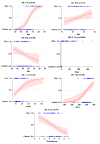Serum Insulin, Insulin-Like Growth Factor-1, Testosterone and Lipid Profile Levels in Benign Prostatic Hyperplasia and Prostate Cancer at Diagnosis
- PMID: 39781138
- PMCID: PMC11707001
- DOI: 10.7759/cureus.75342
Serum Insulin, Insulin-Like Growth Factor-1, Testosterone and Lipid Profile Levels in Benign Prostatic Hyperplasia and Prostate Cancer at Diagnosis
Abstract
Background and objectives: Prostate cancer is the second most frequently diagnosed cancer in men aged 65 years and older globally. The association of prostate cancer with deranged lipid profile and insulin levels is inconsistent and not well understood. This study aimed to analyze the serum levels of lipids, insulin, insulin-like growth factor-1 (IGF-1) and testosterone and to identify their association with the risk of benign prostatic hyperplasia, prostate cancer and its grading.
Materials and methods: This case-control study includes 150 individuals. Cases were 50 newly diagnosed benign prostatic hyperplasia (BPH) and 50 histologically confirmed prostate adenocarcinoma patients. Fifty age-matched disease-free controls were included. Results were analyzed using descriptive statistics and summarized as mean ± standard deviation. ANOVA was used to determine statistically significant differences between two or more categorical groups. Chi-square was used to determine the association between variables of interest.
Results: Data showed that serum insulin and IGF-1 were significantly elevated in prostate cancer and BPH, the highest being in the prostate cancer group, and had a significant positive association with prostate cancer Gleason score and grade. However, lipid profile had non-significant association with prostate cancer Gleason score and grade.
Conclusion: This study confirms the association of insulin and IGF-1 with BPH and prostate cancer Gleason score and grade.
Keywords: benign prostatic hyperplasia; gleason score; insulin; insulin-like growth factor; lipid profile; prostate cancer.
Copyright © 2024, Khan et al.
Conflict of interest statement
Human subjects: Consent for treatment and open access publication was obtained or waived by all participants in this study. IEC (Institutional Ethics Committee) King George's Medical University; Era University issued approval ECR/262/Inst/UP/2013/RR-19; ELMC&H/R_Cell/EC/2020/121A. Animal subjects: All authors have confirmed that this study did not involve animal subjects or tissue. Conflicts of interest: In compliance with the ICMJE uniform disclosure form, all authors declare the following: Payment/services info: All authors have declared that no financial support was received from any organization for the submitted work. Financial relationships: Prof. Anu Chandra declare(s) a grant from Era University. Research Committee of Era University provided intramural funding (ELMC&H/2021/R_Cell/EC/204) for purchase of reagents and kits used in this research work. Other relationships: All authors have declared that there are no other relationships or activities that could appear to have influenced the submitted work.
Figures



Similar articles
-
Insulin-like growth factor (IGF)-I, IGF binding protein-3, and prostate cancer: correlation with Gleason score.Int Braz J Urol. 2015 Jan-Feb;41(1):110-5. doi: 10.1590/S1677-5538.IBJU.2015.01.15. Int Braz J Urol. 2015. PMID: 25928516 Free PMC article.
-
Comparison of chromogranin A, insulin-like growth factor 1 and prostate-specific antigen serum markers in prostate adenocarcinoma and benign prostatic hyperplasia.Urol Int. 2008;80(1):68-73. doi: 10.1159/000111733. Epub 2008 Jan 18. Urol Int. 2008. PMID: 18204237
-
High serum dihydrotestosterone examined by ultrasensitive LC-MS/MS as a predictor of benign prostatic hyperplasia or Gleason score 6 cancer in men with prostate-specific antigen levels of 3-10 ng/mL.Andrology. 2017 Mar;5(2):262-267. doi: 10.1111/andr.12294. Epub 2016 Nov 3. Andrology. 2017. PMID: 27813361
-
Serum insulin-like growth factor-I and insulin-like growth factor-binding protein-3 in localized, metastasized prostate cancer and benign prostatic hyperplasia.Urol Int. 2004;72(1):62-5. doi: 10.1159/000075275. Urol Int. 2004. PMID: 14730168
-
Insulin-like growth factor-binding protein-2 in patients with prostate carcinoma and benign prostatic hyperplasia.Clin Endocrinol (Oxf). 1997 Mar;46(3):333-42. Clin Endocrinol (Oxf). 1997. PMID: 9156044
Cited by
-
Mendelian randomization analysis reveals potential causal relationships between serum lipid metabolites and prostate cancer risk.Discov Oncol. 2025 Apr 24;16(1):602. doi: 10.1007/s12672-025-02388-4. Discov Oncol. 2025. PMID: 40272633 Free PMC article.
References
-
- Hyperinsulinemia and risk of lethal prostate cancer. Tanawattanacharoen VK, Mucci LA, Giovannucci EL. J Clin Oncol. 2023;42
-
- The association between age, prostate cancer risk, and higher Gleason score in a long-term screening program: results from the Göteborg-1 Prostate Cancer Screening Trial. Godtman RA, Kollberg KS, Pihl CG, Månsson M, Hugosson J. Eur Urol. 2022;82:311–317. - PubMed
LinkOut - more resources
Full Text Sources
Miscellaneous
